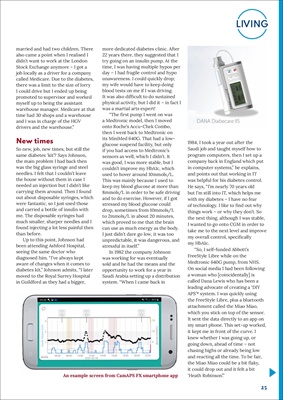
25
LIVING
married and had two children. There
also came a point when I realised I
didn't want to work at the London
Stock Exchange anymore - I got a
job locally as a driver for a company
called Medicare. Due to the diabetes,
there was a limit to the size of lorry
I could drive but I ended up being
promoted to supervisor and worked
myself up to being the assistant
warehouse manager. Medicare at that
time had 30 shops and a warehouse
and I was in charge of the HGV
drivers and the warehouse."
New times
So new, job, new times, but still the
same diabetes 'kit'? Says Johnson,
the main problem I had back then
was the big glass syringe and steel
needles. I felt that I couldn't leave
the house without them in case I
needed an injection but I didn't like
carrying them around. Then I found
out about disposable syringes, which
were fantastic, so I just used those
and carried a bottle of insulin with
me. The disposable syringes had
much smaller, sharper needles and I
found injecting a lot less painful then
than before.
Up to this point, Johnson had
been attending Ashford Hospital,
seeing the same doctor who
diagnosed him. "I've always kept
aware of changes when it comes to
diabetes kit," Johnson admits, "I later
moved to the Royal Surrey Hospital
in Guildford as they had a bigger,
more dedicated diabetes clinic. After
22 years there, they suggested that I
try going on an insulin pump. At the
time, I was having multiple hypos per
day - I had fragile control and hypo
unawareness. I could quickly drop;
my wife would have to keep doing
blood tests on me if I was driving.
It was also difficult to do sustained
physical activity, but I did it - in fact I
was a martial arts expert!
"The first pump I went on was
a Medtronic model, then I moved
onto Roche's Accu-Chek Combo,
then I went back to Medtronic on
its MiniMed 640G. That had a lowglucose
suspend facility, but only
if you had access to Medtronic's
sensors as well, which I didn't. It
was good, I was more stable, but I
couldn't improve my HbA1c, which
used to hover around 10mmols/L.
This was mainly because I used to
keep my blood glucose at more than
8mmols/L in order to be safe driving
and to do exercise. However, if I got
stressed my blood glucose could
drop, sometimes from 10mmols/L
to 2mmols/L in about 20 minutes,
which proved to me that the brain
can use as much energy as the body.
I just didn't dare go low, it was too
unpredictable, it was dangerous, and
stressful in itself."
In 1982 the company Johnson
was working for was eventually
sold and he had the means and the
opportunity to work for a year in
Saudi Arabia setting up a distribution
system. "When I came back in
1984, I took a year out after the
Saudi job and taught myself how to
program computers, then I set up a
company back in England which put
in computer systems," he explains,
and points out that working in IT
was helpful for his diabetes control.
He says, "I'm nearly 70 years old
but I'm still into IT, which helps me
with my diabetes - I have no fear
of technology. I like to find out why
things work - or why they don't. So
the next thing, although I was stable,
I wanted to go onto CGM in order to
take me to the next level and improve
my overall control, specifically
my HbA1c.
"So, I self-funded Abbott's
FreeStyle Libre while on the
Medtronic 640G pump, from NHS.
On social media I had been following
a woman who [coincidentally] is
called Dana Lewis who has been a
leading advocate of creating a 'DIY
APS'* system. I was quickly using
the FreeStyle Libre, plus a bluetooth
attachment called the Miao Miao,
which you stick on top of the sensor.
It sent the data directly to an app on
my smart phone. This set-up worked,
it kept me in front of the curve. I
knew whether I was going up, or
going down, ahead of time - not
chasing highs or already being low
and reacting all the time. To be fair,
the Miao Miao could be a bit flaky,
it could drop out and it felt a bit
'Heath Robinson'."
An example screen from CamAPS FX smartphone app